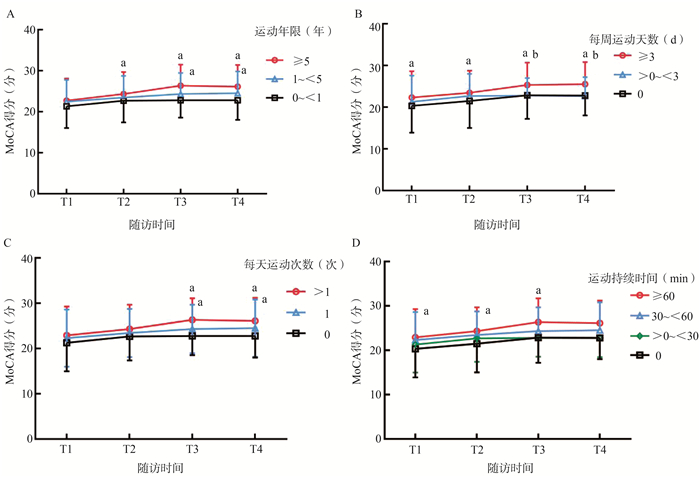A cohort study on the effect of pre-onset physical exercise mediated by serum superoxide dismutase on improving the cognitive function of patients with ischemic stroke
-
摘要:
目的 探讨发病前体育运动对首次缺血性脑卒中患者认知功能短期预后的影响,以及血清超氧化物歧化酶(superoxide dismutase, SOD)的中介作用。 方法 选取2018年7月1日—2019年11月30日蚌埠医学院第一附属医院神经内科缺血性脑卒中首次发病患者512人进行短期随访研究,通过问卷调查患者发病前体育运动相关变量,使用改良版蒙特利尔认知评估(Montreal Cognitive Assessment, MoCA)量表进行认知功能测量和随访评估。采用Logistic回归分析模型分析体育运动对患者认知功能短期预后的影响,采用自助抽样法(bootstrap method)分析血清SOD的中介作用。 结果 与不参加运动组相比,运动年限≥1年、每周运动天数≥3 d、每天运动次数≥1次、运动持续时间30~ < 60 min的缺血性脑卒中患者在出院后3个月、6个月和12个月的MoCA量表得分较高。从运动年限和运动持续时间观察,随访3个月、6个月、12个月,发病前体育运动对认知功能康复的效应不断降低,且3个月和6个月时血清SOD效应修饰作用较强。血清SOD在发病前体育运动促进缺血性脑卒中患者认知功能短期预后的中介作用明显,均在10%左右。 结论 发病前体育运动是缺血性脑卒中患者出院后认知功能恢复的保护因素,其机制与血清SOD存在相关性。 Abstract:Objective To explore the impact of pre-ischemic stroke physical exercise on the short-term prognosis of cognitive function in patients with first ischemic stroke and the mediating role of serum SOD on this effect. Methods In this study, 512 patients who were first-onset diagnosed with ischemic stroke in the department of neurology of the first affiliated hospital of Bengbu Medical College were selected for a short-term cohort study from July 1, 2018 to November 30, 2019. A questionnaire was used to investigate the physical activity-related variables before the onset of the disease, and the modified montreal cognitive assessment (MoCA) scale was used for cognitive function measurement and follow-up evaluation. Logistic regression analysis model was adopted to analyze the effect of physical exercise on the short-term prognosis of cognitive function. The bootstrap method was used to analyze the mediation role of serum SOD. Results Compared with the non-exercise group, the patients who exercised ≥ 3 d a week, exercised at least once a day, and exercised 30~ < 60 min per day for more than 1 year had higher MoCA scale scores at 3, 6, and 12 months after discharge. The effect of physical exercise on cognitive function rehabilitation decreased continuously after follow-up for 3 months, 6 months, and 12 months, and the modification effect of serum SOD was evident at 3 months and 6 months. The mediation effect of serum SOD in promoting the short-term prognosis of cognitive function of ischemic stroke patients by physical exercise was significant, with a mediation effect of about 10%. Conclusion Pre-ischemic stroke regular physical exercise is a protective factor for the recovery of cognitive function after discharge from ischemic stroke, and its mechanism is correlated with serum SOD. -
Key words:
- Ischemic stroke /
- Physical exercise /
- Cognitive function /
- Serum superoxide dismutase /
- Cohort study
-
表 1 2018—2019年研究对象入院时基线调查人口学特征[n (%)]
Table 1. Demographic characteristics of the participants on the baseline survey at admission from 2018 to 2019 [n (%)]
变量 参加运动组
(n=137)不参加运动组
(n=375)t/χ2值 P值 性别 0.143 0.706 男 84(61.31) 223(59.46) 女 53(38.69) 152(40.54) 年龄(x±s,岁) 65.15±11.60 63.41±11.81 1.486 0.138 文化程度 22.109 0.001 小学以下 26(18.98) 113(30.14) 小学 30(21.90) 112(29.87) 初中 38(27.74) 92(24.53) 高中/中专 22(16.05) 37(9.86) 大专 13(9.49) 13(3.47) 本科及以上 8(5.84) 8(2.13) 个人月收入(元) 7.781 0.020 <3 000 80(58.40) 247(65.90) 3 000~<5 000 43(31.40) 113(30.10) ≥5 000 14(10.20) 15(4.00) 住院时间(x±s,d) 20.21±5.60 21.41±5.71 2.116 0.035 吸烟史 4.351 0.114 不吸烟 79(57.66) 200(53.33) 曾经吸烟 32(23.36) 71(18.93) 现在吸烟 26(18.98) 104(27.74) 饮酒史 2.699 0.259 不饮酒 64(46.72) 179(47.73) 曾经饮酒 39(28.47) 83(22.13) 现在饮酒 34(24.81) 113(30.14) 表 2 2018—2019年研究对象入院时基线调查临床特征比较(x±s)
Table 2. Clinical characteristics of the participants on the baseline survey at admission from 2018 to 2019 (x±s)
变量 参加运动组
(n=137)不参加运动组
(n=375)t值 P值 SBP(mm Hg) 142.07±16.23 145.72±16.76 4.849 0.028 DBP(mm Hg) 85.31±13.04 88.78±13.26 6.902 0.009 FPG(mmol/L) 5.95±2.53 6.06±2.76 0.171 0.680 TC(mmol/L) 4.18±1.28 4.32±1.90 0.598 0.440 TG(mmol/L) 2.19±6.82 1.57±0.77 3.074 0.080 LDL-C(mmol/L) 2.27±0.75 2.44±0.82 4.476 0.035 HDL-C(mmol/L) 1.23±1.36 1.00±0.30 9.771 0.002 脂蛋白a(mmol/L) 1.17±0.28 1.13±0.23 2.709 0.100 脂蛋白b(mmol/L) 0.74±0.24 0.78±0.28 2.103 0.148 C反应蛋白(mmol/L) 3.20±4.48 3.90±5.23 1.956 0.163 SOD(μmol/L) 155.31±24.05 150.35±23.27 4.481 0.035 尿酸(mmol/L) 313.78±101.68 306.73±90.82 0.534 0.465 凝血酶时间(min) 17.54±2.13 17.17±2.38 2.552 0.111 表 3 缺血性脑卒中发病前体育运动对患者短期预后认知功能恢复的作用及SOD的效应修饰[RR(95% CI)值]
Table 3. The effect of physical exercise before the onset of ischemic stroke on the recovery of cognitive function of patients with short-term prognosis and the effect modification of SOD [RR (95% CI) value]
变量 出院3个月 出院6个月 出院12个月 模型1 模型2 模型1 模型2 模型1 模型2 运动年限(年) 0~<1 1.000 1.000 1.000 1.000 1.000 1.000 1~<5 1.777(1.542~2.007) 1.454(1.252~1.733) 1.555(1.311~1.788) 1.223(1.019~1.466) 1.007(1.001~1.014) 1.002(0.991~1.321) ≥5 2.008(1.909~2.104) 1.898(1.403~2.123) 1.562(1.311~1.767) 1.245(1.115~1.417) 1.345(1.001~1.429) 1.245(1.001~1.429) 每周运动天数(d) 0 1.000 1.000 1.000 1.000 1.000 1.000 >0~<3 1.556(1.342~1.807) 1.333(1.151~1.622) 1.445(1.278~1.662) 1.311(1.111~1.509) 1.005(1.001~1.011) 1.002(0.941~1.311) ≥3 1.778(1.409~2.002) 1.511(1.301~1.775) 1.555(1.303~1.722) 1.322(1.101~1.499) 1.341(1.003~1.421) 1.215(0.901~1.411) 每天运动次数(次) 0 1.000 1.000 1.000 1.000 1.000 1.000 1 1.558(1.332~1.801) 1.323(1.150~1.626) 1.444(1.278~1.662) 1.310(1.101~1.511) 1.002(1.001~1.009) 1.001(0.881~1.551) >1 1.711(1.428~2.022) 1.509(1.291~1.765) 1.556(1.305~1.725) 1.327(1.102~1.489) 1.346(1.016~1.412) 1.219(0.671~1.559) 运动持续时间(min) 0 1.000 1.000 1.000 1.000 1.000 1.000 >0~<30 1.766(1.542~2.007) 1.345(1.162~1.677) 1.565(1.311~1.788) 1.227(1.033~1.688) 1.245(1.001~1.429) 0.875(0.566~1.888) 30~<60 2.008(1.909~2.104) 1.888(1.202~2.411) 1.562(1.311~1.767) 1.224(1.054~1.676) 1.562(1.311~1.767) 0.768(0.445~1.998) ≥60 1.778(1.542~2.007) 1.567(1.202~1.887) 1.521(1.311~1.788) 1.215(1.087~1.658) 1.212(1.001~1.429) 0.677(0.333~1.979) 注:模型1调整变量:年龄、教育程度、性别、个人月收入;模型2调整变量:年龄、教育程度、性别、个人月收入和血清SOD水平。 表 4 血清SOD在发病前体育运动对缺血性脑卒中患者认知功能短期预后的中介效应分析
Table 4. Analysis of the mediating effect of serum SOD before the onset of physical activity on the short-term prognosis of patients with ischemic stroke
随访时间 总效应
(95% CI)值直接效应
(95% CI)值间接效应
(95% CI)值3月 -0.351
(-0.040~-0.752)-0.211
(-0.052~-0.784)-0.140
(-0.018~-0.411)6月 -0.360
(-0.041~-0.776)-0.218
(-0.051~-0.797)-0.142
(-0.019~-0.415)12月 -0.361
(-0.042~-0.821)-0.231
(-0.053~-0.844)-0.130
(-0.022~-0.407) -
[1] Zhu ZB, Chen LH, Guo DX, et al. Serum rheumatoid factor levels at acute phase of ischemic stroke are associated with poststroke cognitive impairment[J]. J Stroke Cerebrovasc Dis, 2019, 28(4): 1133-1140. DOI: 10.1016/j.jstrokecerebrovasdis.2018.12.049. [2] He XF, Liu DX, Zhang Q, et al. Voluntary exercise promotes glymphatic clearance of amyloid beta and reduces the activation of astrocytes and microglia in aged mice[J]. Front Mol Neurosci, 2017, 10: 144. DOI: 10.3389/fnmol.2017.00144.eCollection2017. [3] Ihle-Hansen H, Langhammer B, Lydersen S, et al. A physical activity intervention to prevent cognitive decline after stroke: secondary results from the life after stroke study, an 18-month randomized controlled trial[J]. J Rehabil Med, 2019, 51(9): 646-651. DOI: 10.2340/16501977-2588. [4] Zhao H, Han Z, Ji X, et al. Epigenetic regulation of oxidative stress in ischemic stroke[J]. Aging Dis, 2016, 7(3): 295-306. DOI: 10.14336/AD.2015.1009. [5] Sacco RL, Kasner SE, Broderick JP, et al. An updated definition of stroke for the 21st century: a statement for healthcare professionals from the American Heart Association/American Stroke Association[J]. Stroke, 2013, 44(7): 2064-2089. DOI: 10.1161/STR.0b013e318296aeca. [6] Guthold R, Stevens GA, Riley LM, et al. Worldwide trends in insufficient physical activity from 2001 to 2016: a pooled analysis of 358 population-based surveys with 1.9 million participants[J]. Lancet Glob Health, 2018, 6(10): e1077-e1086. DOI: 10.1016/S2214-109X(18)30357-7. [7] 陈南星, 刘婷, 蔡奔, 等. 卒中版蒙特利尔认知评估量表的开发及测评[J]. 蚌埠医学院学报, 2020, 45(2): 267-270. DOI: 10.13898/j.cnki.issn.1000-2200.2020.02.036.Chen NX, Liu T, Cai B, et al. Development and evaluation of stroke version montreal cognitive assessment scale[J]. J Bengbu Med Coll, 2020, 45(2): 267-270. DOI: 10.13898/j.cnki.issn.1000-2200.2020.02.036. [8] Zuo LJ, Dong YH, Zhu RY, et al. Screening for cognitive impairment with the montreal cognitive assessment in Chinese patients with acute mild stroke and transient ischaemic attack: a validation study[J]. BMJ Open, 2016, 6(7): e011310. DOI: 10.1136/bmjopen-2016-011310. [9] 顾东风, 翁建平, 鲁向锋. 中国健康生活方式预防心血管代谢疾病指南[J]. 中国循环杂志, 2020, 35(3): 209-230. DOI: 10.3969/j.issn.1000-3614.2020.03.001Gu DF, Weng JP, Lu XF. Chinese guideline on healthy lifestyle to prevent cardiometabolic diseases[J]. Chinese Circulation Journal, 2020, 35(3): 209-230. DOI: 10.3969/j.issn.1000-3614.2020.03.001 [10] Larsson SC, Akesson A, Wolk A. Primary prevention of stroke by a healthy lifestyle in a high-risk group[J]. Neurology, 2015, 84(22): 2224-2228. DOI: 10.1212/WNL.0000000000001637. [11] Wen CP, Liu CH, Jeng JS, et al. Pre-stroke physical activity is associated with fewer post-stroke complications, lower mortality and a better long-term outcome[J]. Eur J Neurol, 2017, 24(12): 1525-1531. DOI: 10.1111/ene.13463. [12] Choi SH, Bylykbashi E, Chatila ZK, et al. Combined adult neurogenesis and BDNF mimic exercise effects on cognition in an Alzheimer's mouse model[J]. Science, 2018, 361(6406): eaan8821. DOI: 10.1126/science.aan8821. [13] Hörder H, Johansson L, Guo X, et al. Midlife cardiovascular fitness and dementia: a 44-year longitudinal population study in women[J]. Neurology, 2018, 90(15): e1298-e1305. DOI: 10.1212/WNL.0000000000005290. [14] Orellana-Urzúa S, Rojas I, Líbano L, et al. Pathophysiology of ischemic stroke: role of oxidative stress[J]. Curr Pharm Des, 2020, 26(34): 4246-4260. DOI: 10.2174/1381612826666200708133912. [15] 侯晓雯. 氧化还原稳态与缺血性卒中后认知障碍的关系及实验干预研究[D]. 沈阳: 中国医科大学, 2020.Hou XW. Relationship between redox homeostasis and cognitive impairment after ischemic stroke and experimental intervention study[D]. Shenyang: China Medical University, 2020. [16] Ding MY, Xu Y, Wang YZ, et al. Predictors of cognitive impairment after stroke: a prospective stroke cohort study[J]. J Alzheimers Dis, 2019, 71(4): 1139-1151. DOI: 10.3233/JAD-190382. [17] Schimidt HL, Vieira A, Altermann C, et al. Memory deficits and oxidative stress in cerebral ischemia-reperfusion: neuroprotective role of physical exercise and green tea supplementation[J]. Neurobiol Learn Mem, 2014, 114: 242-250. DOI: 10.1016/j.nlm.2014.07.005. [18] Damsbo AG, Mortensen JK, Kraglund KL, et al. Prestroke physical activity and poststroke cognitive performance[J]. Cerebrovasc Dis, 2020, 49(6): 632-638. DOI: 10.1159/000511490. [19] Xing Y, Bai Y. A review of exercise-induced neuroplasticity in ischemic stroke: pathology and mechanisms[J]. Mol Neurobiol, 2020, 57(10): 4218-4231. DOI: 10.1007/s12035-020-02021-1. -





 下载:
下载:

